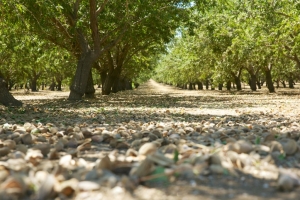The almond harvest is underway at Glenda’s Farmhouse. This time is when the months of nurture, anticipation, growth, and work produce results, and we express gratitude to the workers, trees, and bees for the bounty of almonds received.

Producing almonds falls in line well with the mission of Glenda’s Farmhouse. We aim to provide families with tasty and nutritious food while holding onto traditional values of farming and innovation.
Glenda’s Farmhouse Belief
- We believe in family and community and sharing delicious food with friends and families.
- We believe in good health and providing quality food that nourishes your body.
- We believe that the land and its trees should be treated with respect, sustaining us as they have for decades.
- We believe in innovation and understand that although farming is traditional, we need technology to thrive in today’s economy.
Glenda’s Farmhouse is a daughter company of Andersen and Sons Shelling, operating out of Vino, California. We produce wholesome and high-quality food products. Almonds, for example, can be easily incorporated into almost every meal as a healthy alternative. Almond consumption has been shown to lower bad cholesterol and raise good cholesterol, lessen inflammation, lower blood pressure, and stabilize blood sugars.
What to Expect during Almond Harvesting
The three basic steps in the process include Shaking, Sweeping, and Harvesting. Let’s discuss each of these steps.
Shaking – The shaking equipment used with this step does as indicated by the name. The individual trees are shaken to cause the almonds to fall without causing harm to the trees.
After the nuts fall, they remain in the field to dry for up to a week.
Sweeping – Sufficiently dried, the sweepers will enter the field and direct all of the almonds into the collection area.
Harvesting – The harvest machine steps in after sweeping. This piece of equipment gathers the nuts and sifts out the debris and soil that accompanies the almonds.
Back to the Beginning
Almonds begin with an almond tree. When planted, the tree may require 5-12 years before reaching the age of production. Glenda’s Farmhouse is fortunate to be positioned in the region of the world with the most almond production due to the perfect Mediterranean-esque conditions; that region is California.
The flowers of spring are the first indication of what’s to come. In bloom, pollination needs to occur, and we provide 2,500 acres of bee-friendly land for this element’s accomplishment. The relationship between bees and almond trees is quite important because the nutritious pollen sustains the bees just as the pollination they provide is essential to the tree.
The production phase begins with a drupe, a fuzzy fruit that holds the seed (nut) that we call almonds. Drupes will grow from pollination throughout summer until the appropriate time for harvest.
Shop for Almonds with Glenda’s Farmhouse
Glenda’s Farmhouse provides the opportunity to buy almonds, and other nut products, conveniently and affordably. We offer whole and sliced almonds as well as pecans, walnuts, hazelnuts, cashews, and flavored sea salts. If you’d like to learn more about the harvest, our catalog or place an order, contact us, either online or by phone at 530-839-2236.



